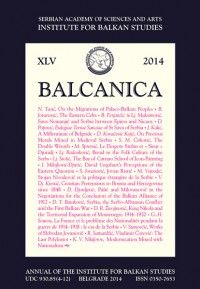A millennium of Belgrade (Sixth-Sixteenth centuries): A Short Overview
A millennium of Belgrade (Sixth-Sixteenth centuries): A Short Overview
Author(s): Jovanka KalićSubject(s): History
Published by: Balkanološki institut - Srpska akademija nauka i umetnosti
Keywords: Belgrade; history; Byzantine Empire; Serbian capital; King Dragutin; Despot Stefan Lazarević; Hungary; Serbs and Ottomans
Summary/Abstract: This paper gives an overview of the history of Belgrade from the reign of Justinian I (527–565), i.e. the time of Slavic settlement, to the Ottoman conquest in 1521. The millennium can be divided into three thematic and chronological units: the Byzantine era (up to 1204), the Serbian era and, finally, the Ottoman era (fifteenth–sixteenth centuries). Within the Byzantine cultural orbit, and especially during the twelfth century, the city played a major role in the relations between the Byzantine Empire and Hungary. Byzantine emperors sojourned in Belgrade on multiple occasions. The city reached its peak during the reign of Despot Stefan in the early fifteenth century. After his death in 1427, the Ottoman threat cast its shadow over the city. Its inhabitants, the Serbs, defended Belgrade for almost a century (1427–1521), thus defending the whole of Central Europe. Belgrade’s fall into the Ottoman hands was followed by the demise of the Kingdom of Hungary in 1526. Even Vienna was threatened by the Ottomans, in 1529.
Journal: BALCANICA
- Issue Year: 2014
- Issue No: 45
- Page Range: 71-96
- Page Count: 26

